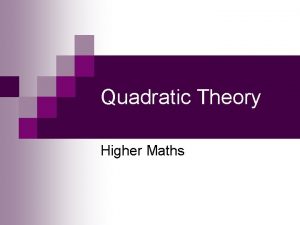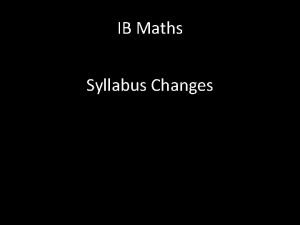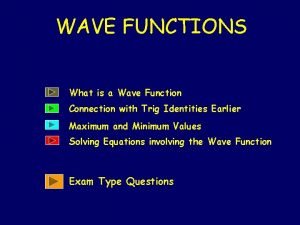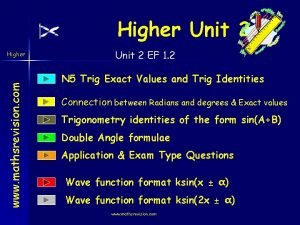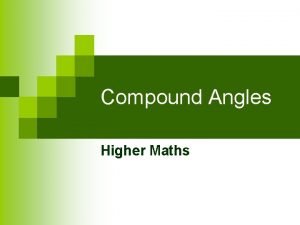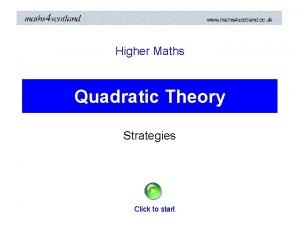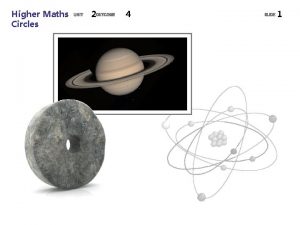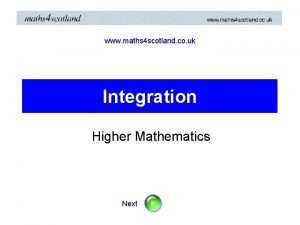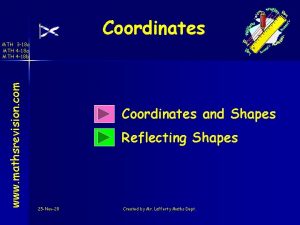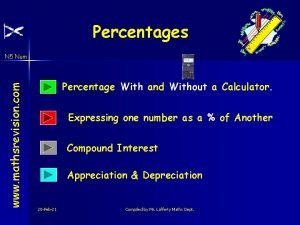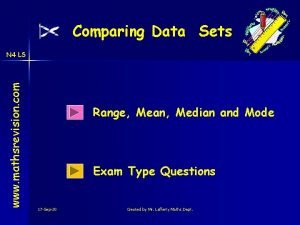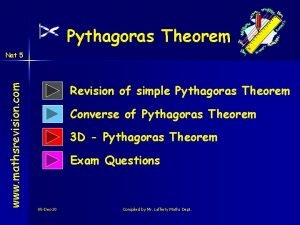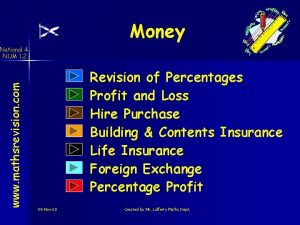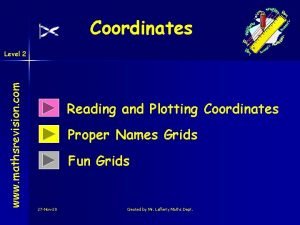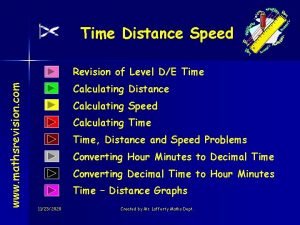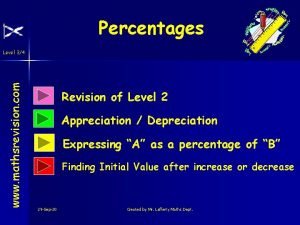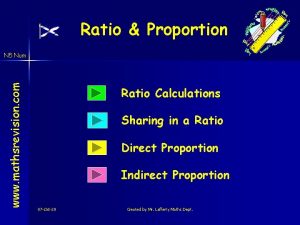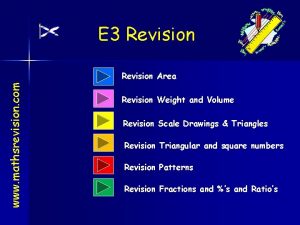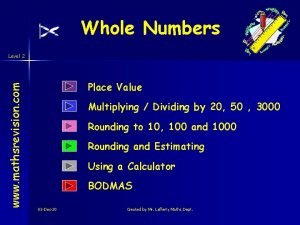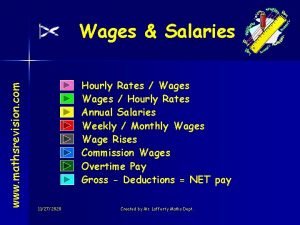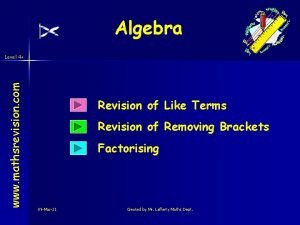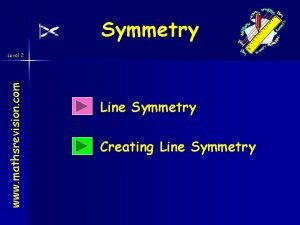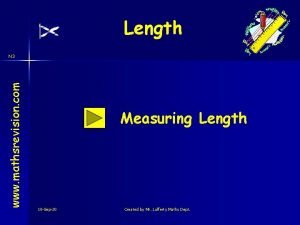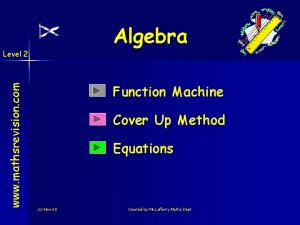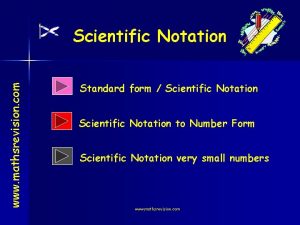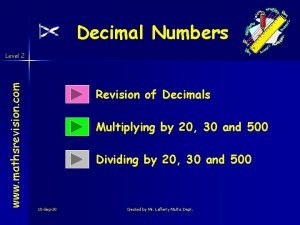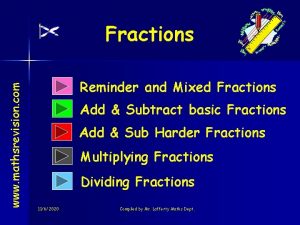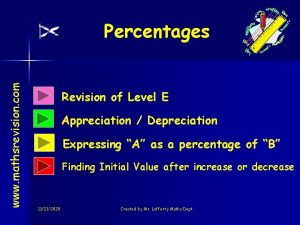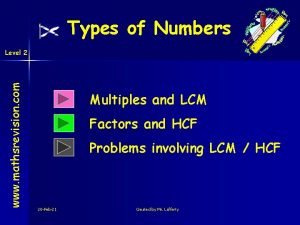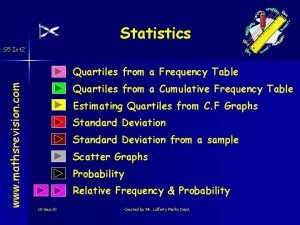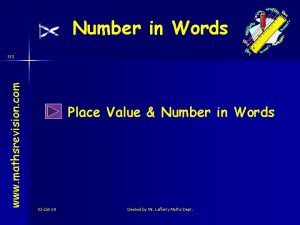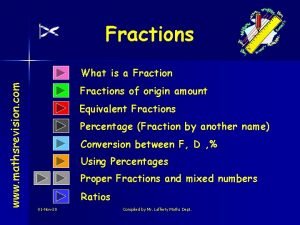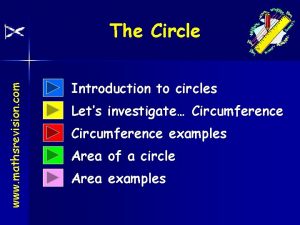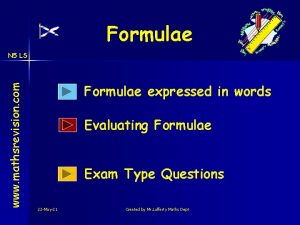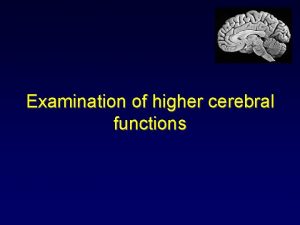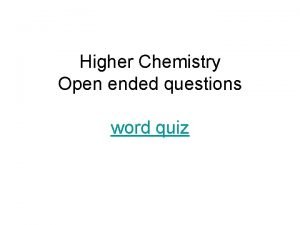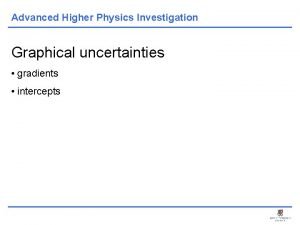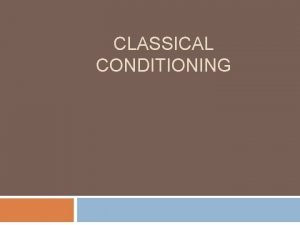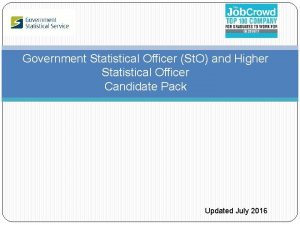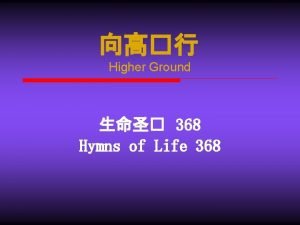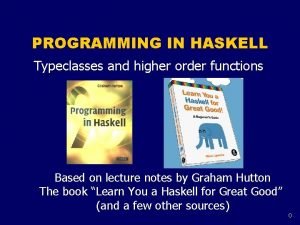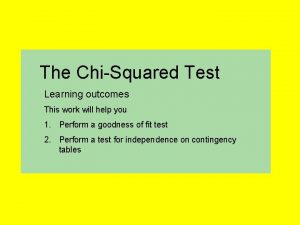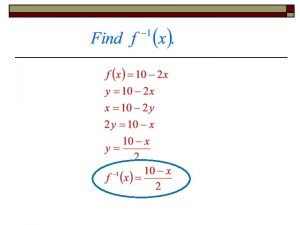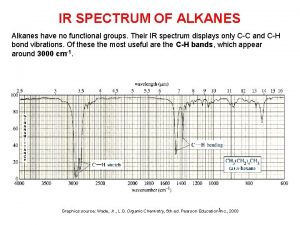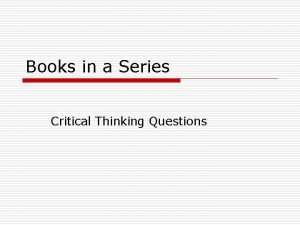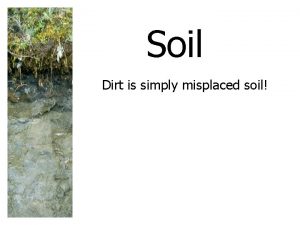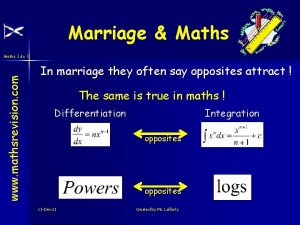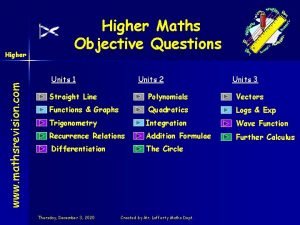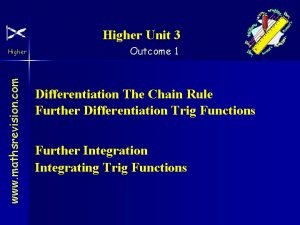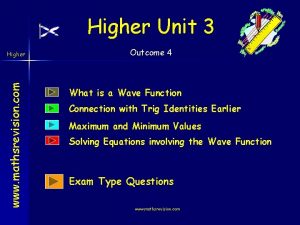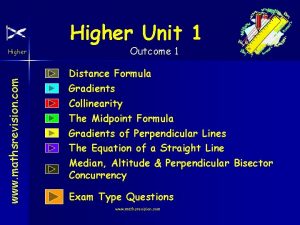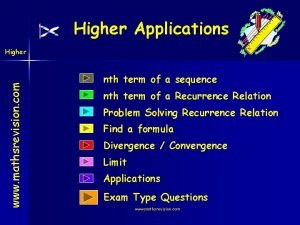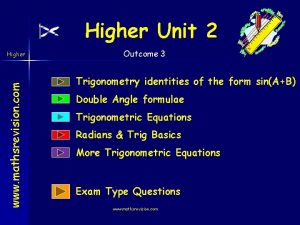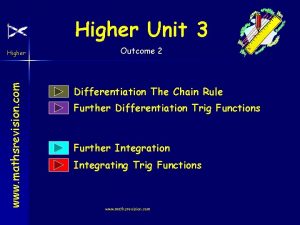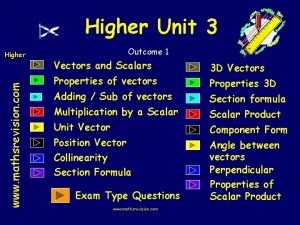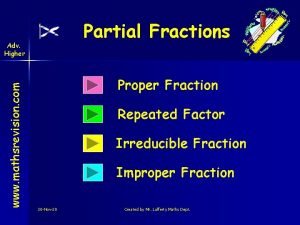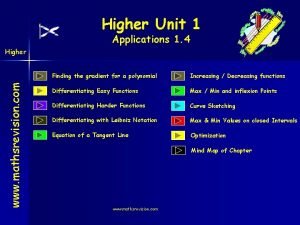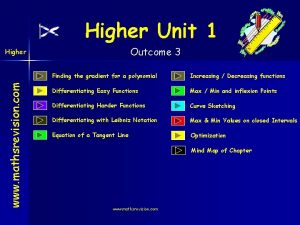www mathsrevision com Higher Maths What is a















































































































- Slides: 111

www. mathsrevision. com Higher Maths What is a set Function in various formats Graph Transformations Exponential Graphs Log Graphs Composite Functions Inverse function Family of Curves Mindmap www. mathsrevision. com Exam Question Type

Sets & Functions Higher www. mathsrevision. com Notation & Terminology SETS: A set is a collection of items which have some common property. These items are called the members or elements of the set. Sets can be described or listed using “curly bracket” notation.

Sets & Functions Higher www. mathsrevision. com We can describe numbers by the following sets: = {1, 2, 3, 4, ………. } N = {natural numbers} W = {whole numbers} Z = {integers} = {0, 1, 2, 3, ………. . } = {…. -2, -1, 0, 1, 2, …. . } Q = {rational numbers} This is the set of all numbers which can be written as fractions or ratios. eg 5 = 5/ 1 -7 = -7/1 55% = 0. 6 = 6/10 = 3/5 55/ 100 = 11/20 etc

www. mathsrevision. com Higher Sets & Functions R = {real numbers} This is all possible numbers. If we plotted values on a number line then each of the previous sets would leave gaps but the set of real numbers would give us a solid line. We should also note that N “fits inside” W W “fits inside” Z Z “fits inside” Q Q “fits inside” R

Higher Sets & Functions www. mathsrevision. com N W Z Q R When one set can fit inside another we say that it is a subset of the other. The members of R which are not inside Q are called irrational numbers. These cannot be expressed as fractions and include , 2, 3 5 etc

www. mathsrevision. com Higher Sets & Functions To show that a particular element/number belongs to a particular set we use the symbol . eg 3 W but 0. 9 Z Examples { x W: x < 5 }= { 0, 1, 2, 3, 4 } { x Z: x -6 } { x R: x 2 = -4 } = { -6, -5, -4, -3, -2, ……. . } = { } or This set has no elements and is called the empty set.

What are Functions ? Nat 5 www. mathsrevision. com Functions describe how one quantity relates to another Car Parts Assembly line Cars Defn: A function or mapping is a relationship between two sets in which each member of the first set is connected to exactly one member in the second set.

What are Functions ? Nat 5 www. mathsrevision. com Functions describe how one quantity relates to another Dirty x Input Washing Machine Function f(x) Clean y Output y = f(x)

Defining a Functions www. mathsrevision. com Nat 5 A function can be thought of as the relationship between Set A (INPUT - the x-coordinate) and SET B the y-coordinate (Output).

Functions Higher www. mathsrevision. com A function can be though of as a black box Function Input x - Coordinate Output f(x) = x 2+ 3 x - 1 Members (x - axis) Domain y - Coordinate Members (y - axis) Co-Domain Image Range

Finding the Function Nat 5 Examples www. mathsrevision. com Find the output or input values for the functions below : 4 12 5 15 6 18 f(x) = 3 x 6 36 f: 0 -1 7 49 f: 1 3 8 64 f: 2 7 f(x) = 4 x - 1 f(x) = x 2

Functions & Mapping Higher www. mathsrevision. com Functions can be illustrated in three ways: 1) by a formula. 2) by arrow diagram. 3) by a graph (ie co-ordinate diagram). Example FORMULA Suppose that f(x) = x 2 + 3 x then f(-3) = 0 , f(1) = 4 f: A B is defined by where A = { -3, -2, -1, 0, 1}. f(-2) = -2 , f(-1) = -2 , f(0) = 0 , NB: B = {-2, 0, 4} = the range!

Functions www. mathsrevision. com Higher A ARROW DIAGRAM f(x) B f(-3) -3 = 0 f(-2) -2 = -2 -1 = -2 f(-1) f(0) 0 =0 1 =4 f(1)

Higher Functions www. mathsrevision. com In a GRAPH we get : NB: This graph consists of 5 separate points. It is not a solid curve.

Functions www. mathsrevision. com Higher A B a b c d e f g Not a function two arrows leaving b! Recognising Functions A a b c d B e f g YES

Functions Higher www. mathsrevision. com A B a b c d e f g Not a function - d unused! A a b c d B e f g h YES

Higher Functions www. mathsrevision. com Recognising Functions from Graphs If we have a function f: R R (R - real nos. ) then every vertical line we could draw would cut the graph exactly once! This basically means that every x-value has one, and only one, corresponding y-value!

Functions Higher www. mathsrevision. com Y Function !! x

Functions Higher www. mathsrevision. com Y Not a function !! Cuts graph more than once ! x must map to one value of y x

Functions Higher www. mathsrevision. com Y Not a function !! Cuts graph more than once! X

Functions Higher www. mathsrevision. com Y Function !! X

Higher Functions www. mathsrevision. com No all functions work every numerical value. Some restriction apply. When a function involves division the denominator CANNOT be equal to zero. Can take square root of a NEGATIVE number.

www. mathsrevision. com Higher Functions For each function below What is the largest possible domain of f(x)

www. mathsrevision. com Higher Functions Ex 11. 1 Page 132

Completing the Square www. mathsrevision. com Higher This is a method for changing the format of a quadratic equation so we can easily sketch or read off key information Completing the square format looks like f(x) = a(x + b)2 + c Warning ! The a, b and c values are different from the a , b and c in the general quadratic function

Completing the Square www. mathsrevision. com Higher Complete the square for x 2 + 2 x + 3 and hence sketch function. Half the x term and square the coefficient. Compensate Tidy up ! f(x) = a(x + b)2 + c x 2 + 2 x + 3 x 2 + 2 x +3 (x 2 + 2 x + 1) -1 + 3 (x + 1)2 + 2 a=1 b=1 c=2

Completing the Square www. mathsrevision. com Higher sketch function. f(x) = a(x + b)2 + c = (x + 1)2 + 2 (0, 3) Mini. Pt. ( -1, 2) (-1, 2)

Completing the Square www. mathsrevision. com Higher Complete the square for 2 x 2 - 8 x + 9 and hence sketch function. f(x) = a(x + b)2 + c 2 x 2 - 8 x + 9 2 - 8 x 2 x +9 Half the x term Take out 2(x 2 - 4 x) + 9 and square the coefficient of Tidy up Compensate ! coefficient. 2 2(x 2 – 4 x + 4) - 8 + 9 x term. 2(x - 2)2 + 1 a=2 b=2 c=1

Completing the Square www. mathsrevision. com Higher sketch function. f(x) = a(x + b)2 + c (0, 9) = 2(x - 2)2 + 1 Mini. Pt. ( 2, 1) (2, 1)

Completing the Square www. mathsrevision. com Higher Complete the square for 7 + 6 x – x 2 and hence sketch function. f(x) = a(x + b)2 + c -x 2 + 6 x + 7 2 + 6 x -x +7 Half the x term Take out 2 - 6 x) -(x +7 2 and square the coefficient of x Tidy up compensate coefficient -(x 2 – 6 x + 9) + 9 + 7 -(x - 3)2 + 16 a = -1 b=3 c = 16

Completing the Square www. mathsrevision. com Higher sketch function. f(x) = a(x + b)2 + c = -(x - 3)2 + 16 Mini. Pt. ( 3, 16) (0, 7)

Completing the Square www. mathsrevision. com Higher By completing the square find the roots of f(x) = x 2 +2 x - 8 = (x + 1)2 -9 = 0 (x + 1)2 = 9 (x + 1) = ± 3 x = ± 3 - 1 x = -4 and 2

Completing the Square www. mathsrevision. com Higher By completing the square find the roots of f(x) = 7 + 6 x – x 2 From previous slide = -(x - 3)2 + 16 = 0 (x - 3)2 = 16 (x - 3) = ± 4 x = ± 4 + 3 x = 7 and -1

Quadratic Theory Given Higher , express in the form Hence sketch function. (0, -8) (-1, 9)

Quadratic Theory a) Write Higher in the form b) Hence or otherwise sketch the graph of a) b) (0, 11) (-3, 2) For the graph of moved 3 places to left and 2 units minimum t. p. at (-3, 2)y-intercept at (0, 11)

www. mathsrevision. com Higher Functions Ex 11. 2 Page 133

Graph Transformations www. mathsrevision. com Higher We will investigate f(x) graphs of the form 1. f(x) ± k 2. f(x ± k) 3. -f(x) 4. f(-x) 5. kf(x) 6. f(kx) Each moves the Graph of f(x) in a certain way !

f(x) - 3 Transformation f(x) ± k f(x) + 5 6 4 Mapping (x , y) (x , y ± k) 2 -6 -4 -2 0 -2 f(x) -4 -6 2 4 6 x 8

Transformation f(x) ± k Keypoints y = f(x) ± k moves original f(x) graph vertically up or down + k move up - k move down Only y-coordinate changes Demo NOTE: Always state any coordinates given on f(x) ± k graph

f(x) - 2 A(-1, -2) B(1, -2) C(0, -3)

f(x) + 1 A(45 o, 1. 5) B(90 o, 1) C(135 o, 0. 5) A(45 o, 0. 5) B(90 o, 0) C(135 o, -0. 5)

f(x + 4) Transformation f(x ± k) f(x - 2) Mapping 6 (x, y) (x ± k , y) 4 2 -6 -4 -2 0 -2 f(x) -4 -6 2 4 6 x 8

Transformation f(x ± k) Keypoints y = f(x ± k) moves original f(x) graph horizontally left or right + k move left - k move right Only x-coordinate changes Demo NOTE: Always state any coordinates given on f(x) on f(x ± k) graph

Transformation -f(x) Mapping 6 (x, y) (x , -y) 4 Flip in x-axis 2 Flip in x-axis -6 -4 -2 0 -2 f(x) -4 -6 2 4 6 x 8

Transformation -f(x) Keypoints y = -f(x) Flips original f(x) graph in the x-axis y-coordinate changes sign Demo NOTE: Always state any coordinates given on f(x) on -f(x) graph

- f(x) C(0, 1) A(-1, 0) B(1, 0)

- f(x) C(135 o, 0. 5) A(45 o, 0. 5) B(90 o, 0) A(45 o, -0. 5) C(135 o, -0. 5)

Transformation f(-x) 6 in Flip y-axis 4 Mapping (x, y) (-x , y) 2 -6 -4 -2 0 -2 f(x) -4 in Flip y-axis -6 2 4 6 x 8

Transformation f(-x) Keypoints y = f(-x) Flips original f(x) graph in the y-axis x-coordinate changes sign Demo NOTE: Always state any coordinates given on f(x) on f(-x) graph


0. 5 f(x) Transformation kf(x) 2 f(x) Stretch in y-axis Mapping 6 (x, y) (x , ky) 4 Compress in y-axis 2 -6 -4 -2 f(x) 0 -2 -4 -6 2 4 6 x 8

Transformation kf(x) Keypoints y = kf(x) Stretch / Compress original f(x) graph in the y-axis direction y-coordinate changes by a factor of k NOTE: Always state any coordinates given on f(x) on kf(x) graph Demo

f(0. 5 x) Transformation f(kx) f(2 x) Mapping 6 Compress in x-axis (x, y) (1/kx , y) 4 2 -6 -4 -2 f(x) 0 2 4 6 x 8 -2 -4 -6 Stretch in x-axis

Transformation f(kx) Keypoints y = f(kx) Stretch / Compress original f(x) graph in the x-axis direction x-coordinate changes by a factor of 1/k NOTE: Always state any coordinates given on f(x) on f(kx) graph Demo

Combining Transformations www. mathsrevision. com Higher You need to be able to work with combinations Demo

Explain the effect the following have (1, 3) (a) -f(x) (b) f(-x) (-1, -3) (c) f(x) ± k 2 f(x) + 1 (1, 3) (-1, -3) (1, 3) Name : f(-x) + 1 -f(x) - 2 (1, 3) (-1, -3) f(x + 1) + 2 Explain the effect the following have f(0. 5 x) (-1, -3) -1 (1, 3) (d) f(x ± k) -f(x + 1) - 3 (-1, -3) (e) kf(x) (f) f(kx) (-1, -3)

(1, 7) Explain the effect the following have (1, 3) (0, 5) (1, 3) (a) -f(x) flip in x-axis (b) f(-x) flip in y-axis (-2, -1) (c) f(x) ± k move up or down (-1, -3) (-1, -5) 2 f(x) + 1 (1, 3) (-1, 1) (-1, -3) f(x + 1) + 2 (-1, 4) Name : f(-x) + 1 -f(x) - 2 (1, -2) (1, -5) (1, 3) Explain the effect the following have f(0. 5 x) (-2, 0) (-1, -3) (1, 3) -1 (2, 2) (d) f(x ± k) move left or right -f(x + 1) - 3 (-1, -3) (0, -6) (1, 3) (e) kf(x) stretch / compress in y direction (e) f(kx) stretch / compress in x direction (-2, -4) (-1, -3)



Graphs & Functions The diagram shows the graph of a function f. f has a minimum turning point at (0, -3) and a point of inflexion at (-4, 2). a) sketch the graph of y = f(-x). b) On the same diagram, sketch the graph of y = 2 f(-x) a) Reflect across the y axis b) Now scale by 2 in the y direction Higher

Graphs & Functions Part of the graph of Higher is shown in the diagram. On separate diagrams sketch the graph of a) b) Indicate on each graph the images of O, A, B, C, and D. a) b) graph moves to the left 1 unit graph is reflected in the x axis graph is then scaled 2 units in the y direction

Graphs & Functions Higher = a) On the same diagram sketch i) a) the graph of ii) the graph of b) Find the range of values of x for which b) is positive Solve: 10 - f(x) is positive for -1 < x < 5

(-1, 8) Graphs & Functions A sketch of the graph of y = f(x) where Higher is shown. The graph has a maximum at A (1, 4) and a minimum at B(3, 0) (1, 4) . Sketch the graph of Indicate the co-ordinates of the turning points. There is no need to calculate the co-ordinates of the points of intersection with the axes. Graph ismoved 2 units to the left, and 4 units upt. p. ’s are:

www. mathsrevision. com Higher Functions Ex 11. 3 Page 137

Exponential (to the power of) Graphs www. mathsrevision. com Higher Exponential Functions A function in the form f(x) = ax where a > 0, a ≠ 1 is called an exponential function to base a. Consider f(x) = 2 x x 1 f(x) -3 -2 -1 0 1 2 3 1/ ¼ ½ 1 2 4 8 8

Graph www. mathsrevision. com Higher The graph of y = 2 x (0, 1) (1, 2) Major Points (i) y = 2 x passes through the points (0, 1) & (1, 2) (ii) As x ∞ y ∞ however as x -∞ y 0. (iii) The graph shows a GROWTH function.

Exponential (to the power of) Graphs www. mathsrevision. com Higher The graph of y = ax always passes through (0, 1) & (1, a) It looks like. . Y y = ax (1, a) (0, 1) x



www. mathsrevision. com Higher Functions Ex 11. 4 Page 139

Log Graphs Higher www. mathsrevision. com ie x y 1/ 8 -3 ¼ ½ 1 2 4 8 -2 -1 0 1 2 3 To obtain y from x we must ask the question “What power of 2 gives us…? ” This is not practical to write in a formula so we say y = log 2 x “the logarithm to base 2 of x” or “log base 2 of x”

Graph www. mathsrevision. com Higher The graph of y = log 2 x NB: x > 0 (2, 1) (1, 0) Major Points (i) y = log 2 x passes through the points (1, 0) & (2, 1). (ii) As x ∞ y ∞ but at a very slow rate and as x 0 y -∞.

Log Graphs www. mathsrevision. com Higher The graph of y = logax always passes through (1, 0) & (a, 1) It looks like. . Y (a, 1) (1, 0) x y = logax





www. mathsrevision. com Higher Functions Ex 11. 5 Page 141

Composite Functions www. mathsrevision. com Higher COMPOSITION OF FUNCTIONS ( or functions of functions ) Suppose that f and g are functions where with where f: A B and f(x) = y and x A, y B g: B C g(y) = z and z C. Suppose that h is a third function where h: A C with h(x) = z.

Composite Functions www. mathsrevision. com Higher A x B f C g y z h We can say that h(x) = g(f(x)) “function of a function”

www. mathsrevision. com Higher Composite f(2)=3 x 2 – 2 =4 g(2)=22 + 1 Example 1 =5 g(4)=42 + 1 Functions =17 f(5)=5 x 3 -2 =13 Suppose that f(x) = 3 x - 2 (a) f(1)=3 x 1 - 2 =1 g( f(2) ) = g(4) f(1)=3 x 1 -2 and g(x) = x 2 +1 = 17 =1 (b) f( g =26 (2) ) = g(26)=262 + 1 =677 f(5) = 13 (c) f( f(1) ) = f(1) = 1 (d) g( g(5) ) g(5)=52 +1 = g(26) = 677

Composite Functions Demo Higher www. mathsrevision. com Suppose that f(x) = 3 x - 2 and Find formulae for (a) g(f(x)) g(x) = x 2 +1 (b) f(g(x)). (a) g(f(x)) = ( )2 + 1 = 9 x 2 - 12 x + 5 (b) f(g(x)) = 3( ) - 2 = 3 x 2 + 1 NB: g(f(x)) f(g(x)) in general. CHECK g(f(2)) = 9 x 22 - 12 x 2 + 5 = 36 - 24 + 5 = 17 f(g(2)) = 3 x 22 + 1 = 13

Composite Functions Higher www. mathsrevision. com Let h(x) = x - 3 , g(x) = x 2 + 4 and k(x) = g(h(x)). If k(x) = 8 then find the value(s) of x. k(x) = g(h(x)) =( )2 + 4 = x 2 - 6 x + 13 Put x 2 - 6 x + 13 = 8 then x 2 - 6 x + 5 = 0 or (x - 5)(x - 1) = 0 So x = 1 or x = 5

Composite Functions Higher www. mathsrevision. com Choosing a Suitable Domain (i) Suppose f(x) = Clearly So So Hence 1. x 2 - 4 0 x 2 4 x -2 or 2 domain = {x R: x -2 or 2 }

Composite Functions Sketch graph www. mathsrevision. com Higher (ii) Suppose that g(x) = (x 2 + 2 x - 8) We need (x 2 + 2 x - 8) 0 Suppose (x 2 + 2 x - 8) = 0 Then (x + 4)(x - 2) = 0 So x = -4 or x = 2 So -4 domain = { x R: x -4 or x 2 } 2







Graphs & Functions Higher The functions f and g are defined on a suitable domain by a) Find an expression for a) b) Difference of 2 squares Simplify b) Factorise

Graphs & Functions Higher and are defined on suitable domai a) Find an expression for h(x) where h(x) = f(g(x)). b) Write down any restrictions on the domain of h. a) b)

Graphs & f. Functions and g are defined on the set of real numbers by a) Find formulae for i) ii) b) The function h is defined by Show that graph of h. a) b) and sketch the Higher

Graphs & Functions Higher a) Find b) If a) b) find in its simplest form.

www. mathsrevision. com Higher Functions Ex 11. 6 Page 143

Inverse Functions Outcome 1 www. mathsrevision. com Higher Nat 5 A Inverse function is simply a function in reverse Function Input Output f(x) = x 2+ 3 x - 1 Output f-1(x) = ? Input

Remember Inverse Function f(x) is simply the Nat 5 Example y-coordinate www. mathsrevision. com Find the inverse function given f(x) = 3 x y = 3 x x= f-1(x) = y 3 x 3 Using Changing the subject rearrange into Rewrite replacing y with x =x. This is the inverse function

Remember Inverse Function f(x) is simply the Nat 5 Example y-coordinate www. mathsrevision. com Find the inverse function given f(x) = x 2 y = x 2 x = √y f-1(x) = √x Using Changing the subject rearrange into Rewrite replacing y with x =x. This is the inverse function

Remember Inverse Function f(x) is simply the Nat 5 Example y-coordinate www. mathsrevision. com Find the inverse function given y = 4 x - 1 Using Changing the subject rearrange into Rewrite replacing x= y+1 4 This is the inverse function f(x) = 4 x - 1 f-1(x) = x+1 4 y with x =x.

www. mathsrevision. com Higher Functions Ex 11. 7 Page 146

Finding a Polynomial From Its Roots Higher www. mathsrevision. com Suppose that f(x) = x 2 + 4 x - 12 and g(x) = -3 x 2 - 12 x + 36 f(x) = 0 g(x) = 0 x 2 + 4 x – 12 = 0 -3 x 2 - 12 x + 36 = 0 (x + 6)(x – 2) = 0 -3(x 2 + 4 x – 12) = 0 x = -6 or x = 2 -3(x + 6)(x – 2) = 0 x = -6 or x = 2 Although f(x) and g(x) have identical roots/zeros they are clearly different functions and we need to keep this in mind when working backwards from the roots.

Finding a Polynomial From Its Roots www. mathsrevision. com Higher If a polynomial f(x) has roots/zeros at a, b and c then it has factors (x – a), (x – b) and (x – c) And can be written as f(x) = k(x – a)(x – b)(x – c). NB: In the two previous examples k = 1 and k = -3 respectively.

Finding a Polynomial From Its Roots Higher www. mathsrevision. com Example y = f(x) 30 -2 1 5

Finding a Polynomial From Its Roots www. mathsrevision. com Higher f(x) has zeros at x = -2, x = 1 and x = 5, so it has factors (x +2), (x – 1) and (x – 5) so f(x) = k (x +2)(x – 1)(x – 5) f(x) also passes through (0, 30) so replacing x by 0 and f(x) by 30 the equation becomes 30 = k X 2 X (-1) X (-5) ie ie 10 k = 30 k=3

Finding a Polynomial From Its Zeros www. mathsrevision. com Higher Formula is f(x) = 3(x + 2)(x – 1)(x – 5) f(x) = (3 x + 6)(x 2 – 6 x + 5) f(x) = 3 x 3 – 12 x 2 – 21 x + 30

www. mathsrevision. com Higher Functions Ex 11. 8 Page 146

Are you on Target ! www. mathsrevision. com Higher • Update you log book • Make sure you complete and correct MOST of the Composite Function questions in the past paper booklet. • Make sure you complete and correct SOME of the Trigonometry questions in the past paper booklet.

f(x) flip in y-axis + Move vertically up or downs depending on k f(x) 0 < k < 1 compress k > 1 stretch f(x) - Stretch or compress vertically depending on k y = f(x) ± k y = f(-x) Remember we can combine these together !! y = kf(x) Graphs & Functions y = -f(x) flip in x-axis y = f(kx) y = f(x ± k) f(x) - + Move horizontally left or right depending on k Stretch or compress horizontally depending on k 0 < k < 1 stretch k > 1 compress

g(x) = f(x) = x 2 - 4 x x 2 Domain x-axis values Input -4 + f(x) = 1 x Domain x-axis values Input 1 x 2 - 4 x 2 -4 g(f(x)) = Write down g(x) with brackets for x 1 g(x) = ( ) inside bracket put f(x) Range y-axis values 1 g(f(x)) = Output 2 x -4 Restriction Composite Functions 1 g(x) = x x g(f(x)) A complex function made up of 2 or more simpler functions Similar to composite Area = 1 x f(g(x)) 1 -4 x 2 Range y-axis values Output x 2 - 4 ≠ 0 (x – 2)(x + 2) ≠ 0 x ≠ 2 x ≠ -2 f(g(x)) = Write down f(x) with brackets for x f(x) = ( )2 - 4 inside bracket put g(x) 1 2 1 -4= -4 f(g(x)) = x x 2 Restriction x 2 ≠ 0

Steps : You need to learn basic movements Exam questions normally involve two movements Remember order BODMAS Sketching Graphs Composite Functions 1. Outside function stays the same EXCEPT replace x terms with a ( ) 2. Put inner function in bracket Restrictions : Functions & Graphs TYPE questions (Sometimes Quadratics) 1. Denominator NOT ALLOWED to be zero 2. CANNOT take the square root of a negative number
 Dậy thổi cơm mua thịt cá
Dậy thổi cơm mua thịt cá Cơm
Cơm The circle shown has equation x^2+y^2=49 a is on the x axis
The circle shown has equation x^2+y^2=49 a is on the x axis Higher maths quadratics
Higher maths quadratics Ib syllabus changes
Ib syllabus changes Is sinx a wave function
Is sinx a wave function Higher maths exact values
Higher maths exact values Higher maths exact value triangles
Higher maths exact value triangles Vectors higher maths
Vectors higher maths Higher maths trig equations
Higher maths trig equations Higher maths circles
Higher maths circles Quadratic theory higher maths
Quadratic theory higher maths Higher maths circle
Higher maths circle Lowther higher maths ebook download
Lowther higher maths ebook download Higher maths exact values table
Higher maths exact values table Integration higher maths
Integration higher maths Higher maths notes
Higher maths notes Mathsrevision.com
Mathsrevision.com Tolerance math
Tolerance math Www.mathsrevision.com
Www.mathsrevision.com Mathsrevision.com
Mathsrevision.com Nat 5 maths pythagoras
Nat 5 maths pythagoras What is a ratio
What is a ratio Mathsrevision
Mathsrevision Mathsrevision
Mathsrevision Maths revision.com
Maths revision.com Www.mathsrevision.com
Www.mathsrevision.com Www.mathsrevision.com
Www.mathsrevision.com Www.mathsrevision.com
Www.mathsrevision.com Mathsrevision.com level 2
Mathsrevision.com level 2 Www.mathsrevision.com
Www.mathsrevision.com Mathsrevision.com
Mathsrevision.com Maths revision .com
Maths revision .com Mathsrevision.com level 2
Mathsrevision.com level 2 Hattrick wage calculator
Hattrick wage calculator Www.mathsrevision.com
Www.mathsrevision.com Line of symmetry
Line of symmetry N3learning
N3learning Mathsrevision.com level 2
Mathsrevision.com level 2 120 700 in scientific notation
120 700 in scientific notation Www.mathsrevision.com
Www.mathsrevision.com Mathsrevision.com
Mathsrevision.com Mathsrevision.com level 3
Mathsrevision.com level 3 Appreciation and depreciation maths
Appreciation and depreciation maths Mathsrevision.com level 2
Mathsrevision.com level 2 Statistics
Statistics Www.mathsrevision.com
Www.mathsrevision.com Www.mathsrevision.com
Www.mathsrevision.com Introduction to circles
Introduction to circles Www.mathsrevision.com
Www.mathsrevision.com Higher certificate in local governance and management
Higher certificate in local governance and management Thinking skills and creativity
Thinking skills and creativity El shorouk academy
El shorouk academy Higher function examination
Higher function examination Montana higher education student assistance corporation
Montana higher education student assistance corporation Guided hypermedia projects
Guided hypermedia projects Kurdistan higher education
Kurdistan higher education Hots bloom's taxonomy
Hots bloom's taxonomy Higher history liberal reforms essay
Higher history liberal reforms essay Higher order functions haskell
Higher order functions haskell Higher chemistry questions
Higher chemistry questions Pearson e text
Pearson e text Mythbusters relative velocity
Mythbusters relative velocity Massachusetts higher education consortium
Massachusetts higher education consortium Middle states commision on higher education
Middle states commision on higher education Higher school of nursing of lisbon
Higher school of nursing of lisbon What is literal imagery
What is literal imagery Jesus higher than the angels
Jesus higher than the angels Ohio department of higher education
Ohio department of higher education What is sound
What is sound Ri board of governors
Ri board of governors Higher technical college
Higher technical college Line of best fit in physics
Line of best fit in physics Training for higher education professionals
Training for higher education professionals Sqa advanced higher english understanding standards
Sqa advanced higher english understanding standards Unconditioned stimulus example
Unconditioned stimulus example Gsg competency framework
Gsg competency framework Higher human biology cellular respiration
Higher human biology cellular respiration Advanced higher dissertation
Advanced higher dissertation The red door annotations
The red door annotations Higher history women's suffrage essay
Higher history women's suffrage essay Higher human biology unit 1 questions and answers
Higher human biology unit 1 questions and answers Emotional factors pe
Emotional factors pe Texas higher education coordinating board
Texas higher education coordinating board Advanced higher history
Advanced higher history Higher close reading
Higher close reading Hymn higher ground lyrics
Hymn higher ground lyrics Higher-order systems
Higher-order systems Haskell higher order functions
Haskell higher order functions Persuasive text about scotland
Persuasive text about scotland Ib lang and lit hl essay examples
Ib lang and lit hl essay examples Advanced higher art
Advanced higher art Higher level needs
Higher level needs Wood despatch 1854
Wood despatch 1854 Higher precision dsp
Higher precision dsp Arkansas higher education coordinating board
Arkansas higher education coordinating board Understanding standards psychology assignment
Understanding standards psychology assignment International baccalaureate higher level
International baccalaureate higher level Polynomial functions of higher degree
Polynomial functions of higher degree Higher thinking skills through it based projects
Higher thinking skills through it based projects Alkanes ir spectrum
Alkanes ir spectrum Costas leveled questions examples
Costas leveled questions examples National 5 ruae
National 5 ruae Pestec higher business
Pestec higher business Texas women in higher education
Texas women in higher education Ministry of higher education (afghanistan)
Ministry of higher education (afghanistan) Maniac magee higher order thinking questions
Maniac magee higher order thinking questions 嘉諾撒聖心商學書院
嘉諾撒聖心商學書院 Higher computing revision
Higher computing revision Gley soil diagram
Gley soil diagram Higher reading for uae
Higher reading for uae Thomson higher education 2007
Thomson higher education 2007



